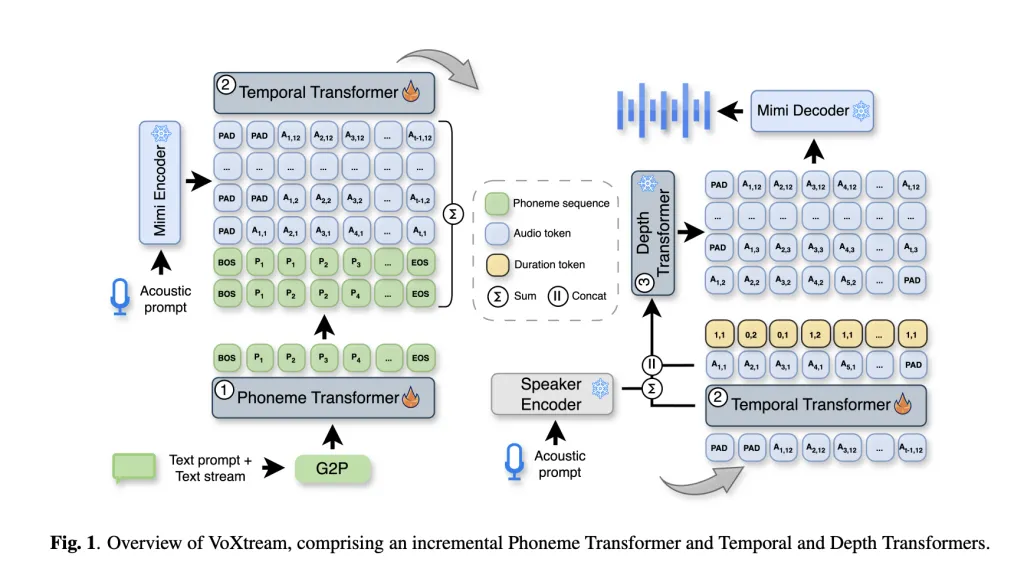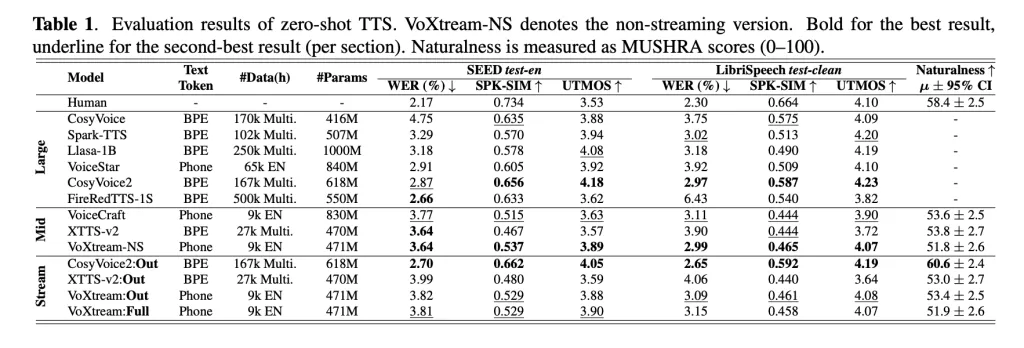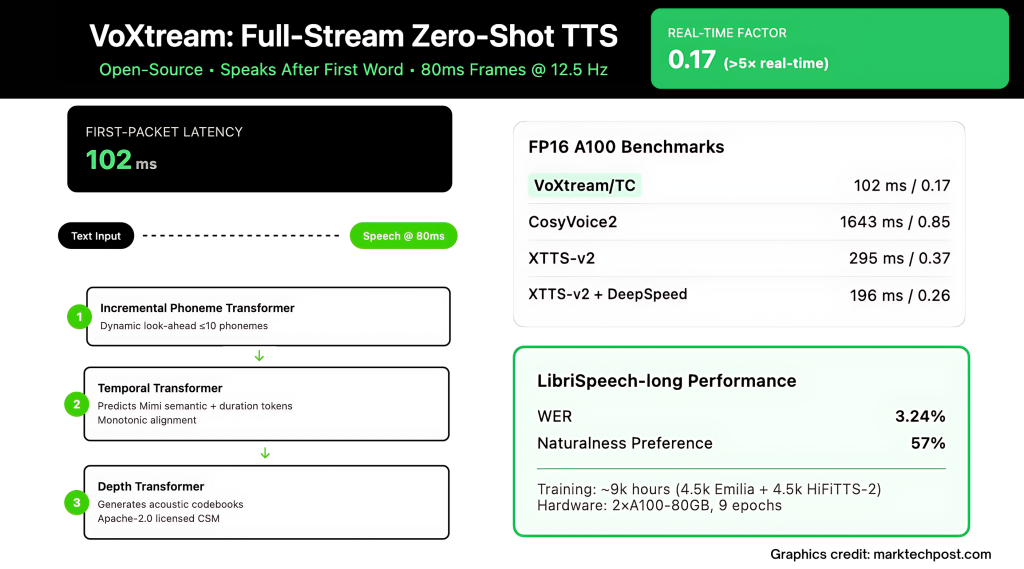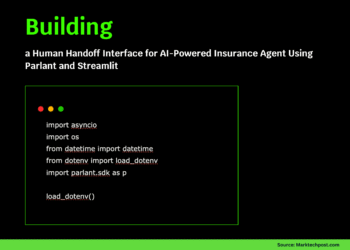Real-time agents, live dubbing, and simultaneous translation die by a thousand milliseconds. Most “streaming” TTS (Text to Speech) stacks still wait for a chunk of text before they emit sound, so the human hears a beat of silence before the voice starts. VoXtream—released by KTH’s Speech, Music and Hearing group—attacks this head-on: it begins speaking after the first word, outputs audio in 80 ms frames, and reports 102 ms first-packet latency (FPL) on a modern GPU (with PyTorch compile).
What exactly is “full-stream” TTS and how is it different from “output streaming”?
Output-streaming systems decode speech in chunks but still require the entire input text upfront; the clock starts late. Full-stream systems consume text as it arrives (word-by-word from an LLM) and emit audio in lockstep. VoXtream implements the latter: it ingests a word stream and generates audio frames continuously, eliminating input-side buffering while maintaining low per-frame compute. The architecture explicitly targets first-word onset rather than only steady-state throughput.

How does VoXtream start speaking without waiting for future words?
The core trick is a dynamic phoneme look-ahead inside an incremental Phoneme Transformer (PT). PT may peek up to 10 phonemes to stabilize prosody, but it does not wait for that context; generation can start immediately after the first word enters the buffer. This avoids fixed look-ahead windows that add onset delay.
What’s the model stack under the hood?
VoXtream is a single, fully-autoregressive (AR) pipeline with three transformers:
- Phoneme Transformer (PT): decoder-only, incremental; dynamic look-ahead ≤ 10 phonemes; phonemization via g2pE at the word level.
- Temporal Transformer (TT): AR predictor over Mimi codec semantic tokens plus a duration token that encodes a monotonic phoneme-to-audio alignment (“stay/go” and {1, 2} phonemes per frame). Mimi runs at 12.5 Hz (→ 80 ms frames).
- Depth Transformer (DT): AR generator for the remaining Mimi acoustic codebooks, conditioned on TT outputs and a ReDimNet speaker embedding for zero-shot voice prompting. The Mimi decoder reconstructs the waveform frame-by-frame, enabling continuous emission.
Mimi’s streaming codec design and dual-stream tokenization are well documented; VoXtream uses its first codebook as “semantic” context and the rest for high-fidelity reconstruction.
Is it actually fast in practice—or just “fast on paper”?
The repository includes a benchmark script that measures both FPL and real-time factor (RTF). On A100, the research team report 171 ms / 1.00 RTF without compile and 102 ms / 0.17 RTF with compile; on RTX 3090, 205 ms / 1.19 RTF uncompiled and 123 ms / 0.19 RTF compiled.
How does it compare to today’s popular streaming baselines?
The research team evaluates short-form output streaming and full-stream scenarios. On LibriSpeech-long full-stream (where text arrives word-by-word), VoXtream shows lower WER (3.24 %) than CosyVoice2 (6.11 %) and a significant naturalness preference for VoXtream in listener studies (p ≤ 5e-10), while CosyVoice2 scores higher on speaker-similarity—consistent with its flow-matching decoder. In runtime, VoXtream has the lowest FPL among the compared public streaming systems, and with compile it operates >5× faster than real time (RTF ≈ 0.17).


Why does this AR design beat diffusion/flow stacks on onset?
Diffusion/flow vocoders typically generate audio in chunks, so even if the text-audio interleaving is clever, the vocoder imposes a floor on first-packet latency. VoXtream keeps every stage AR and frame-synchronous—PT→TT→DT→Mimi decoder—so the first 80 ms packet emerges after one pass through the stack rather than a multi-step sampler. The introduction surveys prior interleaved and chunked approaches and explains how NAR flow-matching decoders used in IST-LM and CosyVoice2 impede low FPL despite strong offline quality.
Did they get here with huge data—or something smaller and cleaner?
VoXtream trains on a ~9k-hour mid-scale corpus: roughly 4.5k h Emilia and 4.5k h HiFiTTS-2 (22 kHz subset). The team diarized to remove multi-speaker clips, filtered transcripts using ASR, and applied NISQA to drop low-quality audio. Everything is resampled to 24 kHz, and the dataset card spells out the preprocessing pipeline and alignment artifacts (Mimi tokens, MFA alignments, duration labels, and speaker templates).
Are the headline quality metrics holding up outside cherry-picked clips?
Table 1 (zero-shot TTS) shows VoXtream is competitive on WER, UTMOS (MOS predictor), and speaker similarity across SEED-TTS test-en and LibriSpeech test-clean; the research team also runs an ablation: adding the CSM Depth Transformer and speaker encoder notably improves similarity without a significant WER penalty relative to a stripped baseline. The subjective study uses a MUSHRA-like protocol and a second-stage preference test tailored to full-stream generation.
Where does this land in the TTS landscape?
As per the research paper, it positions VoXtream among recent interleaved AR + NAR vocoder approaches and LM-codec stacks. The core contribution isn’t a new codec or a giant model—it’s a latency-focused AR arrangement plus a duration-token alignment that preserves input-side streaming. If you build live agents, the important trade-off is explicit: a small drop in speaker similarity vs. order-of-magnitude lower FPL than chunked NAR vocoders in full-stream conditions.
Check out the PAPER, Model on Hugging, GitHub Page and Project Page. Feel free to check out our GitHub Page for Tutorials, Codes and Notebooks. Also, feel free to follow us on Twitter and don’t forget to join our 100k+ ML SubReddit and Subscribe to our Newsletter.
For content partnership/promotions on marktechpost.com, please TALK to us
Asif Razzaq is the CEO of Marktechpost Media Inc.. As a visionary entrepreneur and engineer, Asif is committed to harnessing the potential of Artificial Intelligence for social good. His most recent endeavor is the launch of an Artificial Intelligence Media Platform, Marktechpost, which stands out for its in-depth coverage of machine learning and deep learning news that is both technically sound and easily understandable by a wide audience. The platform boasts of over 2 million monthly views, illustrating its popularity among audiences.



















